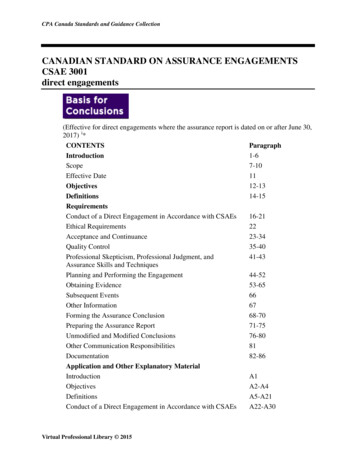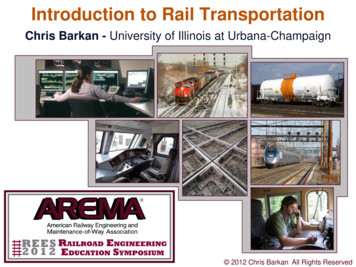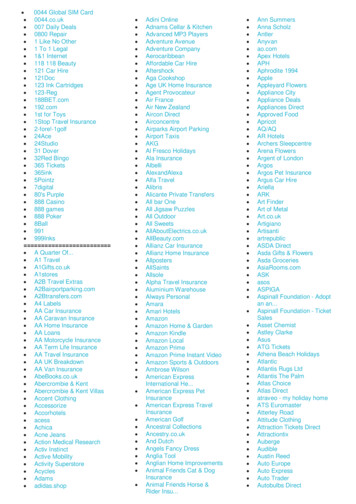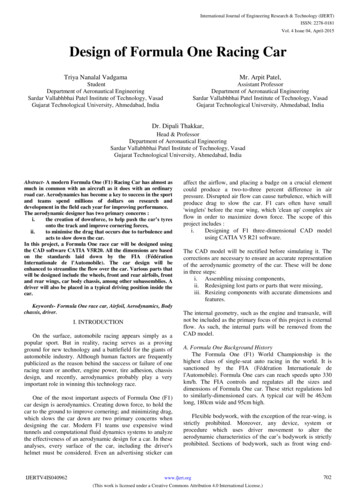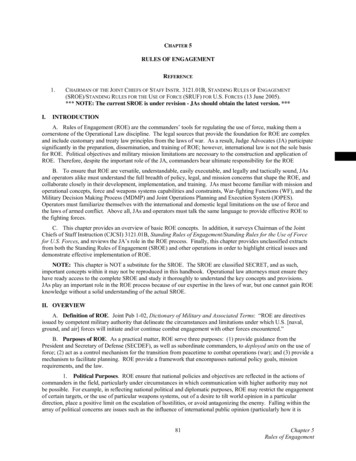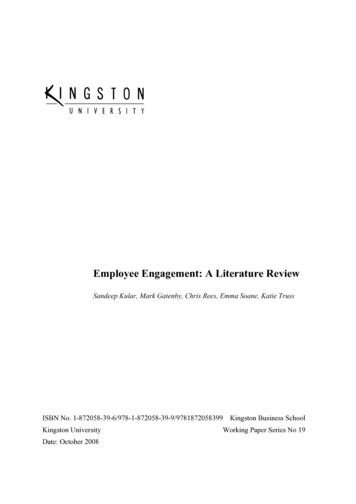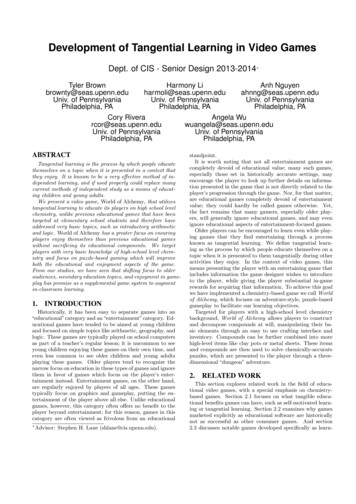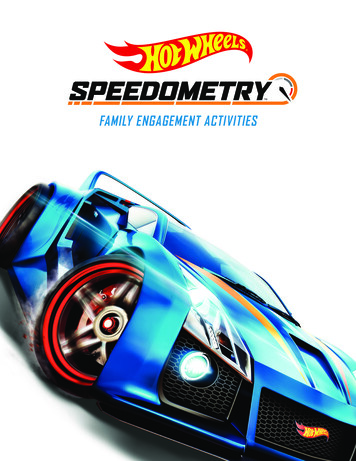
Transcription
FAMILY ENGAGEMENT ACTIVITIES
INTRODUCTIONThese activities are intended to provide a way to practice Science, Math, and Engineeringthrough play. They provide an opportunity for families to share moments of joy, excitement,curiosity, and wonder.The following “Challenges” will guide you to plan and carry out your own scientificinvestigations with Hot Wheels at home—no fancy tools are necessary to explore Science,Technology, Engineering, and Mathematics. Science is all around us. And you don’t haveto be an expert on complicated scientific concepts to do the most basic and most importantsteps of being a scientist: ask questions, observe, explore, and gather evidence from yourobservations to explain what you see. This is a “science through inquiry” approach to learningand it’s easy to do at home.2
HOW TO PLAY1. To begin, read the Challenge question to your child and ask him or her what he or shethinks about that challenge.2. Together, gather the materials that you’ll need to complete this challenge.3. Use the Question Prompts to spur the investigation along. (Hint, reuse the QuestionPrompts below for each challenge).4. Try to do the Challenge again and again OR move on to the next one!QUESTION & ENCOURAGEMENT PROMPTSQuestion and Encouragement Prompts are things to ask your child to encourage thinking orreflection about what is happening and to inspire your child to take the investigation further.Ask these questions or make these statements out loud as you go through the steps of yourinvestigation. What do you see happening? Let’s see if we can make that happen again. What do you notice? Tell me about what you are doing. How might we measure that observation? What does that mean? Tell me more! Wow, that was so cool. What makes you say that? How did you do that? Let’s make a prediction! What could we change to make this That’s interesting! I wonder [why, if] better/faster/go farther? What happens if we ?TIP: Asking questions that prompt critical thinking, or deep thinking, is key to a“learning through play” model. It may feel awkward at first and it may require somepractice before the questions come naturally, but don’t give up—prepare to beamazed at what your child observes and shares with you!3
CHALLENGE #1:HOW FAR, HOW FAST, HOW HIGH AND WHY?Use Hot Wheels tracks and cars to explore the basics of force and motion.What you’ll need: Straight tracks (and a clamp) Two or more cars Stacked books or raised platforms of various heights (such as a coffee table, a desk, abookcase, countertop, or a kitchen table) 15 minutes to play with no other distractions A timer or stopwatch for measuring the speed of cars going down the ramp Optional: paper and pencil to record and track your observationsInvestigationSet up your track as desired. Choose your cars.A. Make some detailed observations or a record of what you see about your cars. Describethe length, weight, and anything else that you notice about them that are special.B. Make some predictions or guesses about what will happen during your investigation withthe cars and the track.Some sample questions to ask: How much of an angle or how high does the track have to be raised for the car(s) to travelall the way across the room or to make it through the loop? Which car do you think will go the fastest? Why?TIP: Remember to be creative and have fun. Try to think of your own questions thatyou or your child might want to explore.C. Use time trials to test the speed of your cars.4
CHALLENGE #1:HOW FAR, HOW FAST, HOW HIGH AND WHY? - CONTINUEDDID YOU KNOW?In many racing sports an athlete, or occasionally a team of athletes, will compete in atime trial for the fastest time. A time trial for this activity is when you set a distance andsee how long it will take each car to finish.BONUS ACTIVITYDo an online search for famous sport time trials to watch. HINT: Cycling, Track & Fieldand Auto Racing are good places to start.Some sample questions to ask? How do you think we could find out how fast it went down the ramp? What are some ways that we might measure the speed or how far it went? What are some ways to make your car go faster or farther?5
CHALLENGE #2:WHAT HAPPENS WHEN CARS CRASH?Use Hot Wheels tracks and cars to set up scenarios in which cars collide with one anotherand make detailed observations (“I notice ” statements) about what happens.WHAT YOU’LL NEED: Straight tracks (and a clamp) or other ramps Other small toys (light and heavy) and household recycle bin itemsInvestigationA. Stage some collisions and observe the transfer of energy from one object to another.How many different ways can your car crash into another? Try: Two cars head on One car hits the other from the back One car hits the side of the other carSome sample questions to ask: What do you notice about the distance each car travels following impact? Which type of collision do you think transfers the most energy?B. Have your cars bang against other household items.How much force might it take to knock down any of the following items? A marble Another car A ball (ping pong, bouncy, golf) An action figure, a stack of blocks Empty yogurt containers Tin cans Plastic bottles Etc.6
CHALLENGE #3:WHAT HAPPENS IF Science investigates cause and effect relationships – if this happens, then that happens. Inthis challenge, explore how you can change the amount of energy needed to make your carsgo faster and/or slower.WHAT YOU’LL NEED: Tracks, clamps, loops, and launchers Cars Tape or string Small items to attach to cars (like coins, paperclips, erasers)InvestigationWhat do you think will happen if we Add this piece of track? Take away that piece of track? Attach something to the car and add mass?7
CHALLENGE #4:HOW CAN I ENGINEER OR DESIGN MY OWN TRACK SYSTEM FROM THINGS AROUND MY HOUSE?What if you don’t have a track system, but you still want to explore new ways to investigate?No trip to the toy store is necessary. You don’t need tracks or even Hot Wheels cars to dothese activities. Explore your home. What are some natural ramps inside and outside yourhouse or apartment? Ask your child to do a “scientific survey” of the area and draw a map ofwhere there are angles and slopes? In addition to the natural ramps, what might you use tomake one from things you can gather from your environment?WHAT YOU’LL NEED: Use rulers to create parallel lines for racing two cars. Lean the rulers up against a wallor coffee table. Glue a few measuring sticks (yardsticks, meter sticks, or rulers) end-toend or side-to-side with a hot glue gun for a sturdier ramp. A long piece of plywood willalso work. Metal cookie sheets makes ramps with less friction. This will make your cars go superfast! Marbles paired with a set of pool noodles make great tunnels for racing. Most bathtubs have just the right amount of slope at one end. Make ramps or even loops using poster board or light cardboard. (Recycled manilafolders work, too!). You’ll need scissors to cut the paper to shape (long rectangles foldedto make three sides of a square) and tape to hold pieces together. Have some extra unused rain gutter? This would make a great ramp as well!Once you’ve created your own track, try replicating the Challenge Activities above.8
CHALLENGE #5:SET UP YOUR OWN INVESTIGATION.Invent your own trials or experiments. Scientists carry out investigations to answer questionsor test solutions to problems. Think of your own design problem and create a solution.Here are 10 easy steps to becoming a scientist at home!1. What is a question that you want to answer through this experiment? Write it down.TIP: Try to frame it as an “I wonder ” question. For example: “I wonder how I canmake my car move as slowly as possible down the track?”2. Discuss how you think you might answer that question or fix that design problem.3. What materials might you need? Gather them!THINGS TO KEEP IN MIND: Most solutions are limited by the materials andresources that are nearby. Consider what you have on hand and be creative with whatyou have available and can use.4. Write down the steps that you are going to do as part of your investigation.5. Set up your track as needed.6. Before you begin, make a prediction.SAMPLE PREDICTION AND FOLLOW-UP QUESTIONS TO ASK: Prediction: Estimate how far the car will travel or how fast. Sample Question 1: What do you think might happen? Sample Question 2: What makes you say that?9
CHALLENGE #5:SET UP YOUR OWN INVESTIGATION.7. Proceed with the steps that you wrote down earlier.8. Reflect or discuss. Ask your child the following questions: What worked and what didn’t? Why do you think that happened?9. Try again and again. Look for patterns.10. Share the results of your experiment with someone else, like another adult in the familyor a sibling.10
SIDEBARS IN THE LESSON:WHAT’S HAPPENING? SCIENCE IN ACTIONPotential energy is stored energy – energy ready to go. When the car is at the top of thetrack, it has potential energy. Kinetic energy is energy in motion. As the car moves throughthe track, it has kinetic energy. Energy can be transferred from potential to kinetic andbetween objects.THINGS TO KEEP IN MIND:Think of activities like a start of a race as in “Ready, Set, Go!” Ready and Set are whenthe car has potential energy. Go marks when potential energy is transformed into kineticenergy. When objects touch or collide, they push on one another and exert a force thattransfers energy between objects. This can change the motion of the object. Motion isjust a change in position of the object.As you explore these Challenges, prompt your child to describe what they are seeing, as wellas what they observe when energy is transferred between objects.11
ON PLAYDID YOU KNOW? Play is more than simply fun. It is serious work and important tosocial-emotional learning in young children. Play helps to develop language skills, controlimpulses, reduce aggression, develop cooperation skills, and develop empathy. Play iscritical for the development of creative problem solving skills. It also helps withphysical development and facilitates sensorimotor development. Hands-on experienceswith real-life materials helps children develop scientific and mathematical skills that theywill need as a professional in the fields of Science, Technology, Engineering, and Math orjust as an informed citizen of the world!12
MARKERS OF SUCCESSFUL PLAYIt is child-driven. Let your child be in charge of the investigations and explain thescience to you. As the adult, take on the role of assistant, listener, and cheerleader. Asklots of questions as you are building and testing the track together. Urge your child toobserve, describe, and explain out loud-- almost like a narrator of a story!There are moments where things don’t go as planned or predicted. Use thequestion and encouragement prompts to support the exploration, but don’t be afraid tolet your child go down a “wrong direction” or fail. Don’t intervene too much. Be positiveand encourage them to try again if something doesn’t work the first time and topersevere when frustrated. These are characteristics of great scientists and engineers.Questions lead to more questions. Once you start asking questions and makingobservations, your child may come up with even more questions—some of which youmay not be able to answer! One of the signs of successful investigation is that it circlesback around to asking more questions. Our kids’ questions often stump us— children arenaturally curious and creative in that way. Congratulate your child on his or her inquiry!You might say, “That’s an interesting question. I’m not sure. How do you think we mightfind an answer?” Explore existing resources: you might look together on the internet,write the question down for your child’s teacher, head to the local library, or visit ascience center or museum.Children have “ah-ha” moments. You might hear them say things like “wow” and “thatis so cool” or “did you see that!”It’s loud and messy. Be prepared to set aside any need for order and neatness for themoment. There may be chaos as supplies are gathered, things are combined together,and everything is spread out over the floor. Before you begin, communicate to your childthat part of the responsibility later will be to work together to clean up.Don’t forget to have fun!13
What are some ways to make your car go faster or farther? In many racing sports an athlete, or occasionally a team of athletes, will compete in a time trial for the fastest time. A time trial for this activity is when you set a distance and see how long it will take each car to finish. D
